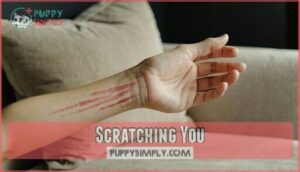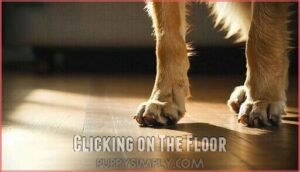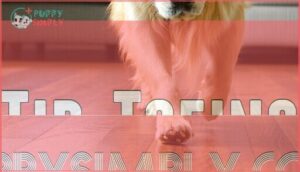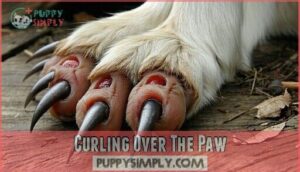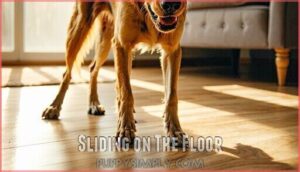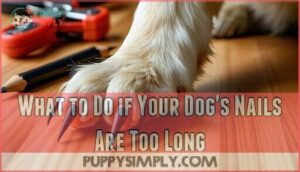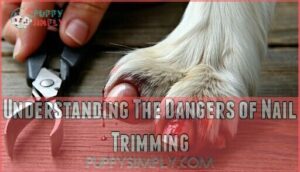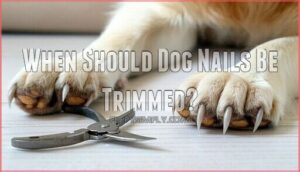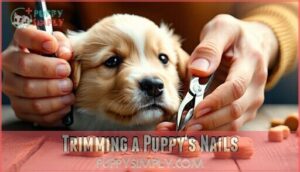This site is supported by our readers. We may earn a commission, at no cost to you, if you purchase through links.
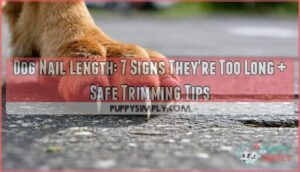 You’ll know your dog’s nail length needs attention when their nails touch the ground while standing normally.
You’ll know your dog’s nail length needs attention when their nails touch the ground while standing normally.
Imagine this scenario: if you hear clicking sounds on hard floors, it’s time for a trim.
Proper dog nail length keeps your pup comfortable and prevents joint problems that affect nearly half of all dogs with overgrown nails.
Watch for these telltale signs: excessive scratching during playtime, tip-toeing walks, or nails that curl over paw pads.
Most dogs need trimming every 3-4 weeks, though active pups who run on concrete might naturally wear theirs down.
Getting the length right isn’t rocket science, but knowing the warning signs can save your furry friend from serious discomfort.
Table Of Contents
- Key Takeaways
- Importance of Dog Nail Care
- Signs Your Dog’s Nails Are Too Long
- What to Do if Your Dog’s Nails Are Too Long
- Finding The Best Dog Nail Clippers
- Understanding The Dangers of Nail Trimming
- When Should Dog Nails Be Trimmed?
- Trimming a Puppy’s Nails
- Frequently Asked Questions (FAQs)
- How long should dog nails be?
- How do you know if a dog has too long nails?
- Are dog nails too long?
- Can a long nail hurt a dog?
- What should a dog’s nails look like?
- Should you trim your dog’s nails?
- What is the right length for dog nails?
- How do you know if your dog’s nails are too long?
- How can I tell where my dog quick is?
- How to avoid the quick when cutting dog’s nails?
- Conclusion
Key Takeaways
- You’ll know it’s time to trim when you hear clicking sounds – If your dog’s nails click on hard floors while walking normally, they’ve grown too long and need immediate attention to prevent joint problems and discomfort.
- Check for these warning signs regularly – Watch for tip-toeing walks, nails curling over paw pads, excessive scratching during play, or your dog sliding on smooth surfaces, as these indicate overgrown nails affecting their mobility.
- Trim every 3-4 weeks to maintain proper length – Most dogs need regular nail maintenance on this schedule, though active dogs who run on concrete might naturally wear theirs down and need less frequent trimming.
- Proper nail length should hover just above the ground – When your dog stands normally, their nails shouldn’t touch the floor or curl under toward their paw pads – think short and neat, not talon-like.
Importance of Dog Nail Care
Your dog’s nail health isn’t just about aesthetics—it’s the foundation of their overall well-being.
Healthy nails aren’t just pretty—they’re the foundation of your dog’s comfort and mobility.
Proper dog nail care importance extends far beyond appearance, directly impacting paw health and walking comfort.
Overgrown dog nails create a domino effect of problems: they alter your pet’s natural gait, leading to joint health issues and posture problems that ripple through their entire body.
Long nails also increase infection prevention risks by trapping dirt and bacteria.
Regular maintenance guarantees your furry friend stays comfortable, mobile, and healthy for years to come.
Regular trimming is vital to prevent nail infections, ensuring your dog remains comfortable and mobile.
Signs Your Dog’s Nails Are Too Long
Recognizing when your dog’s nails need trimming isn’t always obvious, but several clear warning signs can help you stay ahead of potential problems.
From the telltale clicking sounds on your kitchen floor to your pup’s awkward tip-toe walk, these indicators will help you maintain your dog’s comfort and health.
Scratching You
When your dog’s overgrown dog nails leave marks during everyday interactions, it’s a clear warning sign.
Scratch severity increases dramatically with long dog nails, turning gentle greetings into painful encounters. Notice the scratching frequency during playtime or when your pup jumps up for attention.
The scratching context matters too—if normal petting sessions become uncomfortable, those nails need attention.
Preventing scratches starts with regular dog nail trimming. Training solutions work best when combined with proper nail maintenance, protecting both you and your furniture from damage, which is crucial for gentle greetings and overall nail maintenance.
Clicking on The Floor
When your dog walks across hardwood or tile floors, you’ll hear a distinct clicking sound.
This noise indicates their nails are hitting the surface with each step. The clicking causes come from overgrown dog nails that extend beyond the paw pad.
Different floor types amplify this sound differently, but the nail angle and walking style make it unmistakable.
Proper dog nail length should eliminate this clicking entirely.
Tip-Toeing
When your dog’s nails are too long, they’ll start tip-toeing to avoid discomfort.
This altered gait creates toe pressure and joint stress throughout their body.
You’ll notice muscle imbalance and posture changes as they compensate for overgrown nails.
These gait alterations aren’t just cosmetic—they signal real pain.
Proper dog nail length prevents these joint issues and maintains your pup’s natural, comfortable stride.
Curling Over The Paw
When nails curve like tiny talons toward your dog’s paw pads, you’re looking at serious nail overgrowth.
This nail curling happens when trimming gets skipped too long, creating painful pressure points.
The severity levels range from slight curves to nails actually touching the pads.
Regular preventative measures like monthly trimming prevent this uncomfortable situation, though severe cases need veterinary intervention before attempting any trimming methods, which can help prevent painful pressure points.
Sliding on The Floor
Watch your pup slip and slide like they’re on ice? Overgrown nails reduce paw grip on smooth surfaces, creating an unnatural gait that affects their confidence and safety.
- Hardwood floors become skating rinks – Long nails can’t provide proper traction solutions
- Tile surfaces turn treacherous – Surface impact increases when nail length indicators show overgrowth
- Breed variations matter – Larger dogs struggle more with slippery floors
- Dog nail trimming restores stability – Proper dog nail length improves overall dog gait
What to Do if Your Dog’s Nails Are Too Long
When you discover your dog’s overgrown nails, swift corrective measures prevent joint issues and discomfort.
Your dog’s overgrown nails aren’t just unsightly—they’re a gateway to serious health problems that demand immediate attention.
Start with gradual trimming—remove small amounts weekly rather than cutting drastically at once. This approach allows the quick to recede naturally while maintaining proper dog nail length. A key step involves identifying the quick to avoid causing pain or bleeding.
| Nail Length Indicators | Action Required | Professional Help |
|---|---|---|
| Slightly overgrown | Weekly small trims | Optional grooming visit |
| Moderately long | Bi-weekly gradual trimming | Vet consultation recommended |
| Severely overgrown | Daily tiny cuts | Immediate professional care |
| Curled into pads | Emergency trimming | Urgent vet consultation |
For severe cases, vet consultation guarantees proper pain management and infection prevention during dog nail trimming recovery.
Finding The Best Dog Nail Clippers
Once you’ve decided it’s time to trim those overgrown nails, choosing the right tool makes all the difference. The best dog nail clippers come down to personal preference and your pup’s size.
Clipper Types matter most. Skip guillotine-style clippers—they crush more than cut. Scissor-style clippers work better for clean cuts. For anxious dogs, a dog nail grinder offers more control and smoother finishes.
Blade Material should be sharp stainless steel that stays sharp longer. Dull blades split nails instead of cutting them cleanly.
Grip Comfort prevents hand fatigue during longer sessions. Look for non-slip handles that fit your hand size.
Safety Features like quick-stop guides help prevent over-cutting. Some models include nail files or LED lights.
Budget Options don’t mean cheap quality. Safari Professional and Miller’s Forge offer reliable nail clippers under twenty dollars that’ll last years. For ideal results, consider clippers with sharp, durable blades for clean cuts.
Understanding The Dangers of Nail Trimming
Having the right clippers doesn’t guarantee a smooth nail trimming session. You’ll need to understand the risks involved to keep your furry friend safe and comfortable.
Cutting Too Short poses the biggest threat. When you nick the quick (the pink tissue inside the nail), you’ll cause immediate pain and bleeding. This traumatic experience can create lasting dog nail anxiety, making future sessions even more challenging.
Here are the main dangers you should watch for:
- Infection Risks – Cracked or cut nails can expose the quick to harmful bacteria
- Pain Management – Hitting blood vessels and nerves causes significant discomfort
- Bleeding Control – Quick dog nail cuts require immediate styptic powder application
- Long-Term Damage – Poor technique can lead to permanent nail problems and posture issues
Remember, your dog’s nail bleeding isn’t just messy—it’s genuinely painful. Take your time, cut conservatively, and prioritize your pet’s comfort over speed. Regular trimming helps prevent irreversible paw damage.
When Should Dog Nails Be Trimmed?
Every dog’s trimming schedule depends on their growth rate and activity level.
Most dogs need nail trims every 3-4 weeks to maintain proper dog nail length and prevent overgrown nails. However, breed influence plays a role—larger breeds may need more frequent care.
You can find various dog nail clippers online.
| Dog Size | Trimming Frequency | Growth Rate | Activity Impact | Special Notes |
|---|---|---|---|---|
| Small breeds | Every 2-3 weeks | Fast | Low activity = more frequent | Indoor dogs need regular care |
| Medium breeds | Every 3-4 weeks | Moderate | Balanced growth | Standard dog nail trimming frequency |
| Large breeds | Every 4-5 weeks | Slower | High activity = natural wear | Concrete walks help |
| Senior dogs | Every 2-3 weeks | Variable | Reduced activity | Monitor nail health closely |
| Puppies | Weekly checks | Very fast | Learning phase | Start dog nail care early |
Regular dog nail care prevents painful overgrowth and maintains ideal nail length for your pup’s comfort.
Trimming a Puppy’s Nails
Starting your puppy’s nail trimming routine early makes a world of difference.
Begin around six weeks old, even if there’s barely anything to trim.
Handle their paws daily to get them comfortable with the sensation.
Use dog nail clippers designed for small nails, and focus on just the very tip to avoid the quick.
Desensitization techniques work wonders—let them sniff the clippers first.
Positive reinforcement with treats keeps things pleasant.
If you’re handling squirmy puppies, try trimming one nail per session until they’re used to it, using desensitization techniques and ending with positive reinforcement.
Frequently Asked Questions (FAQs)
How long should dog nails be?
Like a freshly sharpened pencil, your dog’s nails should hover just above the ground when they’re standing.
You shouldn’t hear clicking on hard floors, and they shouldn’t curl under or touch their paw pads.
How do you know if a dog has too long nails?
You’ll hear clicking sounds when your dog walks on hard floors, see nails curling under or extending past paw pads, and notice limping or altered gait from discomfort.
Are dog nails too long?
You’ll know your dog’s nails are too long if they click on hard floors, curl under, or touch the ground while standing.
They should hover slightly above the surface for comfort.
Can a long nail hurt a dog?
Yes, long nails can seriously hurt your dog.
They cause pain while walking, create joint problems, lead to infections, and can curl into paw pads.
Regular trimming prevents these painful issues.
What should a dog’s nails look like?
Your dog’s nails should hover just above the ground when they’re standing normally.
They shouldn’t click on hard floors or curl under toward the paw pads.
Think short and neat, not talon-like.
Should you trim your dog’s nails?
Like Goldilocks finding the perfect porridge, you’ll want your dog’s nails "just right."
Trim them every 2-4 weeks to prevent clicking sounds, discomfort, and potential joint problems that develop from overgrown nails.
What is the right length for dog nails?
Your dog’s nails should hover just above the ground when standing—no clicking sounds on hard floors.
Think of it like keeping fingernails neat: long enough for grip, short enough for comfort.
How do you know if your dog’s nails are too long?
Listen for clicking sounds when your dog walks on hard floors.
Check if nails curl under or extend past paw pads.
Watch for limping, slipping, or reluctance to walk—these signal it’s trimming time.
How can I tell where my dog quick is?
Finding your dog’s quick is like spotting a hidden treasure – it’s the pinkish area inside the nail.
On light nails, you’ll see it clearly.
Dark nails require careful trimming, cutting tiny bits until you spot the quick.
How to avoid the quick when cutting dog’s nails?
Cut small amounts at a 45-degree angle, stopping when you see a dark circle or pink center.
Trim gradually every week to help the quick recede naturally, making future cuts safer and easier.
Conclusion
Think of proper dog nail length as the foundation of your pet’s comfort—without it, everything else crumbles.
You’ve learned the seven warning signs and safe trimming techniques to keep your furry friend happy.
Regular nail maintenance every 3-4 weeks prevents painful joint issues and keeps those clicking sounds at bay.
Remember, you don’t need professional grooming experience to master this skill.
With patience and the right tools, you’ll confidently maintain your dog’s nail health.
- https://idealcompaniondogtraining.com/2020/04/01/proper-nail-length-and-care/
- https://www.portagepark.com/blog/the-dangers-of-your-dogs-nails-being-too-long
- https://www.walkervillevet.com.au/blog/do-dogs-need-their-nails-clipped/
- https://wagsandwiggles.com/the-importance-of-keeping-your-dogs-nails-at-the-appropriate-length/
- https://www.quora.com/How-often-should-I-trim-my-pets-nails-to-ensure-they-are-at-a-comfortable-length

